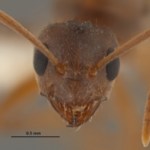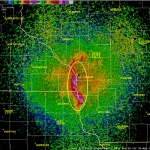Crazy ant image by Joe A. MacGown with the Mississippi Entomological Museum
Tawny (or Raspberry) crazy ants (Nylanderia fulva) are an invasive ant species from South America that have been invading the United States. For some reason, the ants are attracted to electronics and have been responsible for the destruction of numerous electronic devices.
A new study shows that tawny crazy ants rub formic acid over their bodies as a shield against fire ant venom. This conclusion came after researchers observed the ants rubbing themselves with formic acid after a confrontation with fire ants (…
swarm
Nature is big. Really big! The US National Weather Service revealed this image taken last Saturday showing a massive swarm of newly-hatched mayflies erupting from the Mississippi River near La Crosse, Wisconsin.
The swarm was captured using doppler radar, which is used to track the direction and velocity of distant objects (it's the same type of technology used by traffic police in speed guns). The National Weather Service says:
The bugs are showing up as bright pink, purple, and white colors along the Mississippi River mainly south of La Crosse, WI. After the bugs hatch off the water…
The Great Earthquake Swarm at Yellowstone that ushered in 2010 seems to be dying down, at least according to the USGS earthquake reports and analysis of the seismicity by the University of Utah and YVO. The daily updates on the earthquake swarms by Utah has ended. Looking at the earthquake over the last 7 days (see below), you can notice three things quickly: (1) since 2/6, there are much fewer quakes compared to a week and a half ago; (2) any sign the earthquakes were getting shallower seems to have ended; and (3) they seem to be generally smaller ( M1.5). Now, what does that mean? Like many…
Outcrops of Obsidian Butte, California, near the Salton Sea.
A brief update on the two earthquake swarms making news right now:
Yellowstone
The earthquake swarm at Yellowstone is still rumbling along, reaching over 1,000 earthquakes measured over the last week. However, the swarm has begun to die down overnight - with no earthquakes between 10:41 PM (MST) on 1/22 and 6 AM on 1/23. However, although this is a longer, bigger swarm than normal, it still isn't out of the regular rumblings at Yellowstone caldera. The USGS continues to say this swarm is tectonic, rather than magmatic or…
Since December 26, seismologists have observed over 400 seismic events at Yellowstone National Park—a record number of earthquakes for the hot spot which houses the largest supervolcano in North America. Data is still being analyzed to determine what this "swarm"—a sequence of earthquakes similar in magnitude—could mean. ScienceBlogger Greg Laden will be following the events closely on his blog.


